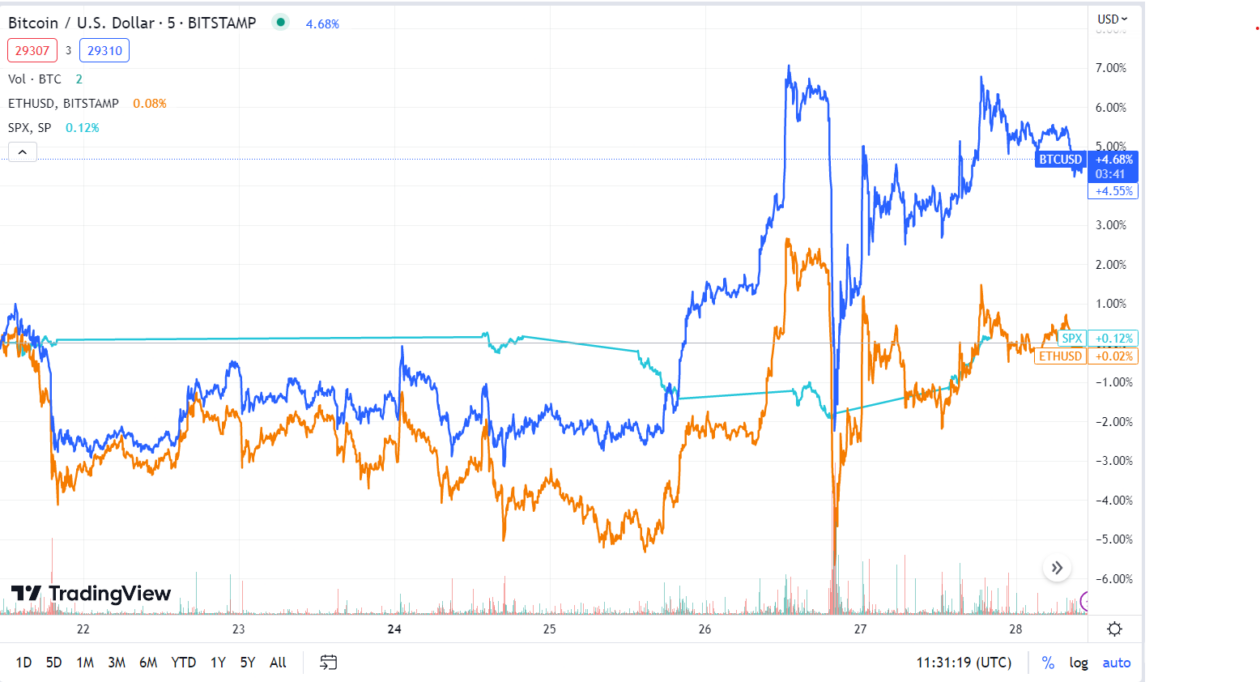Bitcoin rose 4.54% from April 21 to 28 to trade at US$29,272 at 7 p.m. on Friday in Hong Kong.
The world’s largest cryptocurrency by market capitalization has been trading below US$30,000 since April 19. Ether fell 0.06% over the week to US$1,911.

Bitcoin tested the US$27,000 resistance multiple times throughout the week but remained above it.
“Bitcoin needs to close above US$32,000 to confirm an upward trend,” Tom Wan, a research analyst at 21.co, the parent company of 21Shares, an issuer of crypto exchange-traded products, wrote in an email to Forkast. “The first support is US$27,500. If it [falls below that], the next support will be US$25,000 to 25,900.”
The global crypto market capitalization stood at US$1.21 trillion on Friday at 7 p.m. in Hong Kong, up 1.6% from US$1.19 trillion a week ago, according to CoinMarketCap data. Bitcoin’s US$566 billion market cap accounted for 47.04% of the market, while Ether’s US$230 billion accounted for 19.1%.
Market concerns over the state of the U.S. banking industry resurfaced this week following weak financial reports from two major banks. First Republic reported a 41% decrease in deposits for the first quarter, leading to a 45.4% drop in its share prices on Tuesday. Swiss banking giant UBS revealed a 52% decline in net profit for the same period.
Standard Chartered predicts Bitcoin surge
According to Geoff Kendrick, head of digital assets research at Standard Chartered, the crypto winter is over and Bitcoin could rise to US$100,000 by the end of 2024.
“I’m very confident that we will reach that point eventually,” said Justin d’Anethan, institutional sales director at digital assets firm Amber Group.
“It’s in the realm of possibility [but] whether it’s happening next year that I can’t comment on,” he added.
Kendrick said in a note shared with Reuters, that Bitcoin could benefit from the recent banking crisis, the stabilization of risk assets after the U.S. Federal Reserve ends its rate hiking cycle and Bitcoin mining profitability rises.
The next Bitcoin halving is expected to occur in 2024, with the exact date depending on the rate of new block production. During the halving occurrence, mining rewards for each block will be reduced by half. This means that miners will receive only 3.125 Bitcoin per block mined, compared to the current reward of 6.25 Bitcoin per block. This reduction in mining rewards is a key feature of Bitcoin’s design, intended to control the rate of Bitcoin production and ultimately limit the total supply of Bitcoin to 21 million coins.
“Halving will play a role in catalyzing the price of Bitcoin,” Wan of 21.co said. “In addition, Ordinals, BRC-20, and scaling solutions like Stacks will also play a huge role in fueling the upward trend for Bitcoin in the long run.”
Jamie Coutts, a senior market structure analyst at Bloomberg Intelligence, said that Bitcoin could start siphoning value from the global bond market due to negative real rates and real returns. If just 1% of global bond market value moved toward Bitcoin, the network’s market cap would rise north of US$3 trillion, bringing prices to US$185,000, he said.
“Traditional allocators will inevitably begin to weigh the possibility that a non-sovereign bearer asset with zero counterparty risk, like Bitcoin, could be an alternative to bonds issued by profligate governments. In this scenario, a 1% shift from sovereign debt would push BTC back to around previous highs,” wrote Coutts in a research note shared with Forkast.
See related article: Crypto bounces back after rumor mill scare
Biggest gainers: RNDR, INJ
The Render Network’s token (RNDR) was this week’s biggest gainer among the top 100 coins by market capitalization listed on CoinMarketCap, rallying 40.03% to US$2.50. The token started its rally on Monday, in anticipation of two proposals for the protocol’s expansion to the Solana blockchain. Both proposals were approved on Wednesday.
The Render Network allows idle graphics processing units to be used for the digital rendering needed in fields like 3D modeling, gaming imagery, and virtual reality.
INJ, the native governance token of Injective, a layer-1 smart contract blockchain, was this week’s second-biggest gainer in the top 100. INJ rose 17.45% to US$8.85. INJ started gaining momentum on Tuesday after Injective announced a partnership with Celer Network to enable cross-chain asset transfers.
Next week: All eyes on U.S. nonfarm payrolls
Wan of 21.co expects Bitcoin to close April above US$30,000 in the bullish case, but warned that falling under US$27,000 is also in play. Next month’s price movement will depend on the macro environment and regulatory developments in the U.S., he said.
Investors are expecting the release of the U.S. jobs report next Friday, which includes economic indicators such as nonfarm payrolls. Economists typically use this data to gauge the Fed’s move on interest rates next month. Nearly 90% of the 105 economists polled by Reuters expect the Fed to announce a 25 basis point hike next month.
See related article: US response to crypto is like ‘deer caught in headlights,’ says ex-CFTC chair






